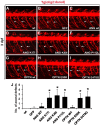Yeast genetic interaction screen of human genes associated with amyotrophic lateral sclerosis: identification of MAP2K5 kinase as a potential drug target
- PMID: 28596290
- PMCID: PMC5580709
- DOI: 10.1101/gr.211649.116
Yeast genetic interaction screen of human genes associated with amyotrophic lateral sclerosis: identification of MAP2K5 kinase as a potential drug target
Abstract
To understand disease mechanisms, a large-scale analysis of human-yeast genetic interactions was performed. Of 1305 human disease genes assayed, 20 genes exhibited strong toxicity in yeast. Human-yeast genetic interactions were identified by en masse transformation of the human disease genes into a pool of 4653 homozygous diploid yeast deletion mutants with unique barcode sequences, followed by multiplexed barcode sequencing to identify yeast toxicity modifiers. Subsequent network analyses focusing on amyotrophic lateral sclerosis (ALS)-associated genes, such as optineurin (OPTN) and angiogenin (ANG), showed that the human orthologs of the yeast toxicity modifiers of these ALS genes are enriched for several biological processes, such as cell death, lipid metabolism, and molecular transport. When yeast genetic interaction partners held in common between human OPTN and ANG were validated in mammalian cells and zebrafish, MAP2K5 kinase emerged as a potential drug target for ALS therapy. The toxicity modifiers identified in this study may deepen our understanding of the pathogenic mechanisms of ALS and other devastating diseases.
© 2017 Jo et al.; Published by Cold Spring Harbor Laboratory Press.
Figures








Similar articles
-
Human-yeast genetic interaction for disease network: systematic discovery of multiple drug targets.BMB Rep. 2017 Nov;50(11):535-536. doi: 10.5483/bmbrep.2017.50.11.118. BMB Rep. 2017. PMID: 28683849 Free PMC article.
-
Novel deletion mutations of OPTN in amyotrophic lateral sclerosis in Japanese.Neurobiol Aging. 2012 Aug;33(8):1843.e19-24. doi: 10.1016/j.neurobiolaging.2011.12.037. Epub 2012 Mar 7. Neurobiol Aging. 2012. PMID: 22402017
-
Mutations in the ubiquitin-binding domain of OPTN/optineurin interfere with autophagy-mediated degradation of misfolded proteins by a dominant-negative mechanism.Autophagy. 2015 Apr 3;11(4):685-700. doi: 10.4161/auto.36098. Autophagy. 2015. PMID: 25484089 Free PMC article.
-
Dysfunction of Optineurin in Amyotrophic Lateral Sclerosis and Glaucoma.Front Immunol. 2018 May 23;9:1017. doi: 10.3389/fimmu.2018.01017. eCollection 2018. Front Immunol. 2018. PMID: 29875767 Free PMC article. Review.
-
Optineurin in amyotrophic lateral sclerosis: Multifunctional adaptor protein at the crossroads of different neuroprotective mechanisms.Prog Neurobiol. 2017 Jul;154:1-20. doi: 10.1016/j.pneurobio.2017.04.005. Epub 2017 Apr 26. Prog Neurobiol. 2017. PMID: 28456633 Review.
Cited by
-
Map2k5-Deficient Mice Manifest Phenotypes and Pathological Changes of Dopamine Deficiency in the Central Nervous System.Front Aging Neurosci. 2021 Jun 8;13:651638. doi: 10.3389/fnagi.2021.651638. eCollection 2021. Front Aging Neurosci. 2021. PMID: 34168549 Free PMC article.
-
Refined Phylogenetic Ortholog Inference Reveals Coevolutionary Expansion of the MAPK Signaling Network Through Finetuning of Pathway Specificity.J Mol Evol. 2025 Jun;93(3):423-440. doi: 10.1007/s00239-025-10254-8. Epub 2025 May 30. J Mol Evol. 2025. PMID: 40447942
-
Cross-Species Complementation of Nonessential Yeast Genes Establishes Platforms for Testing Inhibitors of Human Proteins.Genetics. 2020 Mar;214(3):735-747. doi: 10.1534/genetics.119.302971. Epub 2020 Jan 14. Genetics. 2020. PMID: 31937519 Free PMC article.
-
Interrogation of kinase genetic interactions provides a global view of PAK1-mediated signal transduction pathways.J Biol Chem. 2020 Dec 11;295(50):16906-16919. doi: 10.1074/jbc.RA120.014831. Epub 2020 Oct 15. J Biol Chem. 2020. PMID: 33060198 Free PMC article.
-
Identification of Genetic Modifiers of TDP-43: Inflammatory Activation of Astrocytes for Neuroinflammation.Cells. 2021 Mar 18;10(3):676. doi: 10.3390/cells10030676. Cells. 2021. PMID: 33803845 Free PMC article.
References
-
- Anborgh PH, Godin C, Pampillo M, Dhami GK, Dale LB, Cregan SP, Truant R, Ferguson SS. 2005. Inhibition of metabotropic glutamate receptor signaling by the huntingtin-binding protein optineurin. J Biol Chem 280: 34840–34848. - PubMed
-
- Babin PJ, Goizet C, Raldua D. 2014. Zebrafish models of human motor neuron diseases: advantages and limitations. Prog Neurobiol 118C: 36–58. - PubMed
MeSH terms
Substances
Grants and funding
LinkOut - more resources
Full Text Sources
Other Literature Sources
Medical
Molecular Biology Databases
Research Materials
Miscellaneous
